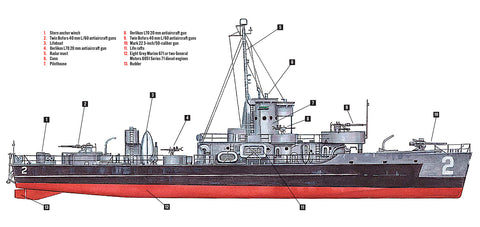
A Closer Look at the U.S. Navy’s ‘Mighty Midget’
Specifications
Propulsion: Eight Gray Marine 6-71 or two General Motors 6051 Series 71
diesel engines totaling 1,600 hp and driving twin variable-pitch propellers
Length: 158 feet 6 inches
Beam: 23 feet 3 inches
Maximum draft: 5 feet 8 inches Displacement (unladen): 250 tons
Displacement (fully loaded): 387 tons
Complement: Six officers, 65 enlisted
Maximum speed: 16.5 knots Range: 5,500 miles at 12 knots
Armament: One Mark 22 3-inch/50-caliber gun; two twin Bofors 40 mm L/60
antiaircraft guns; four Oerlikon L70 20 mm antiaircraft guns; four .50-caliber
machine guns; 10 Mark 7 rocket launchers
Among the bitter lessons learned during the costly American seizure of Japanese-occupied Tarawa in November 1943 was the need for ship-based close support in the interval between bombardment and a landing. Using the hull of the LCI (landing craft infantry) as a basis, the Navy devised the Landing Craft Support (Large) (Mark 3), or simply LCS. Entering service in 1944 and combat at Iwo Jima in February 1945, it packed the heaviest armament per ton of any warship, earning the sobriquet “Mighty Midget”. British Commonwealth forces also used it in Borneo, at Tarakan and Balikpapan.
Of the 130 built, only five were lost—three sunk by Japanese Shinyo suicide motorboats in the Philippines and two falling victim to kamikaze aircraft off Okinawa. After supporting the Okinawa landings, the LCSs were fitted with radar and joined destroyers on picket duty against kamikaze attacks. It was while so engaged that Lieutenant Richard Miles McCool Jr., commander of LCS-122 , saw the destroyer William D. Porter mortally stricken on June 10, 1945, by an Aichi D3A2, yet managed to rescue its crew without loss. The next evening two D3As hit LCS-122 , but the seriously wounded McCool rallied his men to save their vessel and was subsequently awarded the Medal of Honor. In 1949 the LCS was reclassified the LSSL (landing ship support large), and it continued to serve in Korea, Vietnam and other conflicts in foreign hands until 2007. One of two survivors discovered in Thailand is undergoing restoration to its World War II configuration at the Landing Craft Support Museum [usslcs102.org] in Vallejo, Calif.
Fitted from
stem to stern with guns, the LCS would precede landing craft to the invasion
beaches, softening up enemy defenses with its guns and barrages of 4.5-inch
rockets.
This story appeared in the Winter 2024 issue of Military History magazine.
historynet magazines
Our 9 best-selling history titles feature in-depth storytelling and iconic imagery to engage and inform on the people, the wars, and the events that shaped America and the world.
